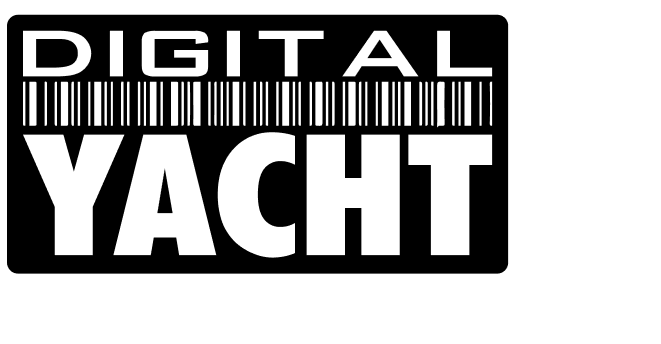

AIT2000 – Class B AIS Transponder
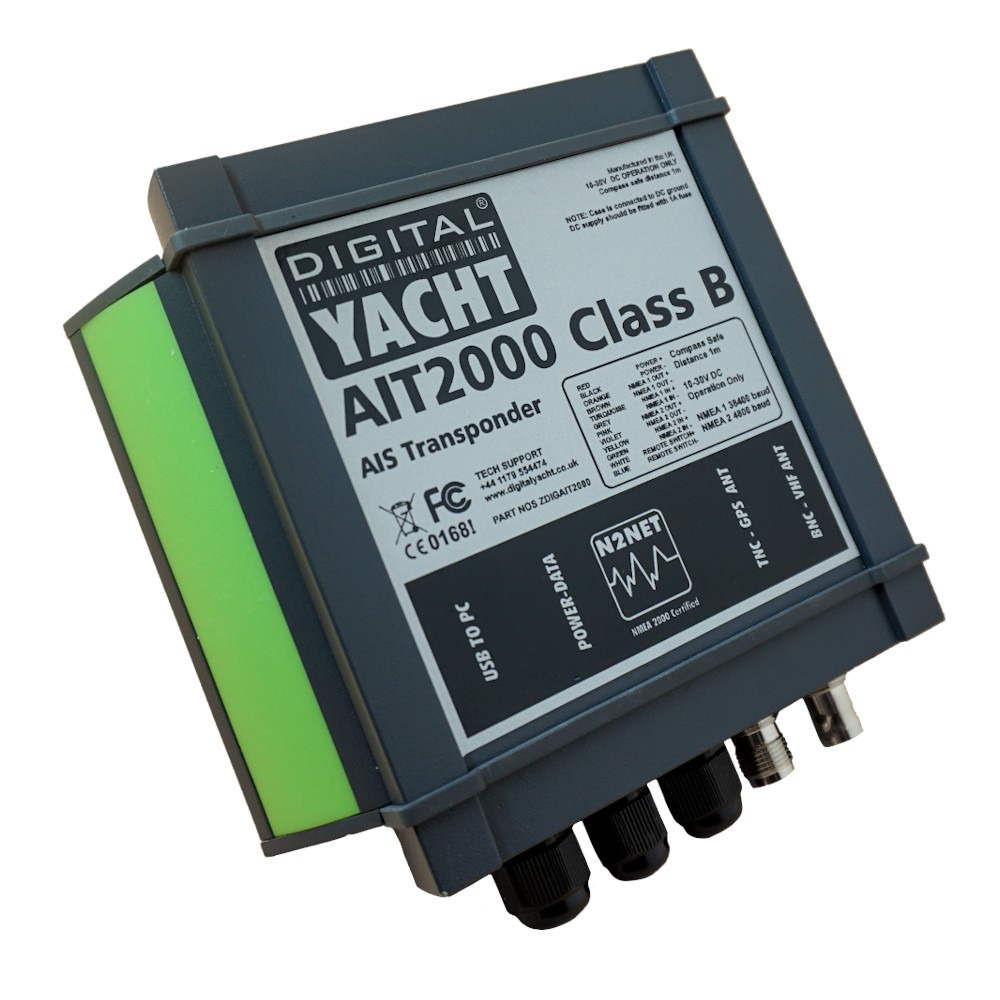
“ Ultra-compact AIS Transponder Class B that uses the latest AIS transponder technology to squeeze more performance and interfacing options with half the size of our previous generation transponder. “
- Manuals & Downloads
- Additional information
- What inside box
- Product Video
Description
What’s the len value of the ais.
All Digital Yacht AIS transponders have the LEN value = 1, except our AIT1500N2K which has LEN = 6.
AIT2500/AIT5000 Disable NMEA 2000 Heading Reception
All Class B and Class B+ AIS transponders can transmit the True Heading of the vessel as part of the dynamic data they transmit to other vessels; MMSI Number, Position, COG, SOG, etc. If received most charting systems will plot the AIS target with both the COG and True Heading vector displayed, useful when the vessel is stationary and COG becomes unstable/inaccurate.
Our AIT2500 and AIT5000 units can receive the True Heading (HDT or THS sentences) data via their Low Speed NMEA 0183 Input (Yellow+ and Green- wires) or via PGN#127250 Vessel Heading on NMEA 2000.
However, not all NMEA 2000 systems will transmit True Heading and in some cases they transmit a wrong value or just a fixed 000º. This results in the AIS target being plotted with a very strange heading vector or the boat appearing to be moving side-ways or backwards.
If this happens and you cannot correct or suppress the True Heading value on the NMEA 2000 network, then you can stop the AIT2500/AIT5000 from receiving True Heading over NMEA 2000, by following the procedure below….
Using the proAIS2 software, go to the Serial Data tab and then copy and paste the following commands in to the box at the bottom of the page and click the “Send” button (see image below).

- To stop reception of True Heading data over NMEA 2000 send this command: $PSMT,0,3,0x2C75B2FA,1,n2kignss 0,0*13
- To enable it again send this command: $PSMT,0,3,0x2C75B2FA,1,n2kignss 1,0*12
….if the command was successfully received and actioned, you should see Transponder respond with…
- $PSMT,255……….etc . (basically, the same as the command but 255 instead of 0 after the $PSMT, text)
AIS Transponder Status light flashing red
A flashing RED Status LED indicates a high VSWR reading or potentially a Power Amplifier fault.
For the flashing RED Status LED issue, with the 12v power turned off to the AIS Transponder, I would visually inspect the BNC antenna connector on the AIS and make sure there are no signs of connector damage. Then connect up whichever VHF antenna you have the most confidence in. Now power ON the AIS Transponder and immediately join its wireless network and bring up the web interface before the unit has got a GPS position fix and tried to transmit or use ProAIS2 if your AIS transponder don’t have a web interface.
Now watch the VSWR reading and see what value is displayed after the first couple of transmissions. If it is greater than 5:1, then it has a high VSWR and will soon start to flash the RED Status LED.
The most common cause is the VHF antenna and connections, but if you are confident that they are all fine, then it must be the unit itself and we will need to get it back for warranty repair.
My AIS Transponder is not transmitting
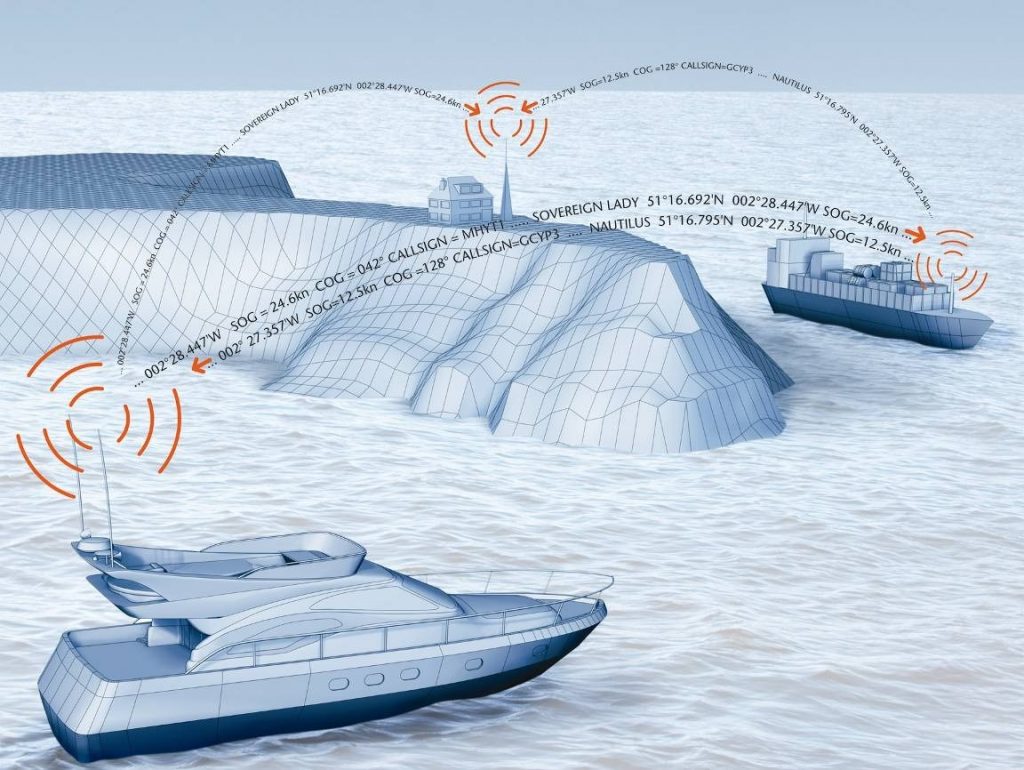
If you think that your AIS transponder is not transmitting your position then this procedure might help you. The first step is to check if your AIS transponder is actually transmitting. If you are then sure that your AIS transponder is not transmitting then the next part explains you the factors to check.
1 – Check if your AIS is transmitting or not
With proais2 or iaistx/ait5000 web interface.
Using the proAIS2 configuration software or the iAISTX/AIT5000 web interface allows you to see if the GPS position is OK. You can monitor the AIS reception of other vessels. As well as ensure that there are no errors or alarms. However, if you are new to AIS, there is always that nagging doubt as to whether other vessels are seeing you.
Check with a local AIS Receiver/Transponder
The best test of a Class B transponder is to ask someone else in your marina, who has AIS, to check that they are receiving you on their system. If your vessel is stationary, then a transponder will only transmit every 3 minutes. This increases to every 30 seconds when your speed over the ground (SOG) is greater than 2 knots. Therefore, do allow some time for them to detect you. Also when they first receive your transmission, the only data they will see is your position, speed, course and MMSI number. It can take up to 6 minutes to receive your “Static Data” (boat name, call sign, vessel type, dimensions, etc.). This is normal and is the way the AIS system regulates the amount of data being transmitted.
Check with MarineTraffic, Vessel Finders, etc.
The other increasingly common method of testing an AIS transponder is to look on one of the online “live” AIS websites and the most popular of the free services is MarineTraffic.com
However, it is important for you to be aware of the limitations of these online sites. As a result, do not assume that you will always be picked up by them. Each of the different online services are only as good as their network of AIS receiving stations. In many cases enthusiasts/volunteers operate these. In some areas the coverage is great but there are definitely “holes” in coverage.
2 – Find out the reasons why your AIS is not transmitting
If you are now sure that your AIS transponder is not transmitting then you should follow the following steps.
You must use ProAIS2 for your AIT1500, AIT2000, AIT2500, AIT3000 or Nomad. However, for the iAISTX, iAISTX Plus or AIT5000, you must use the built-in web interface.
With proAIS2’s diagnostics tab or the iAISTX/AIT5000 web interface, you can check if an AIS transponder has an issue or not.
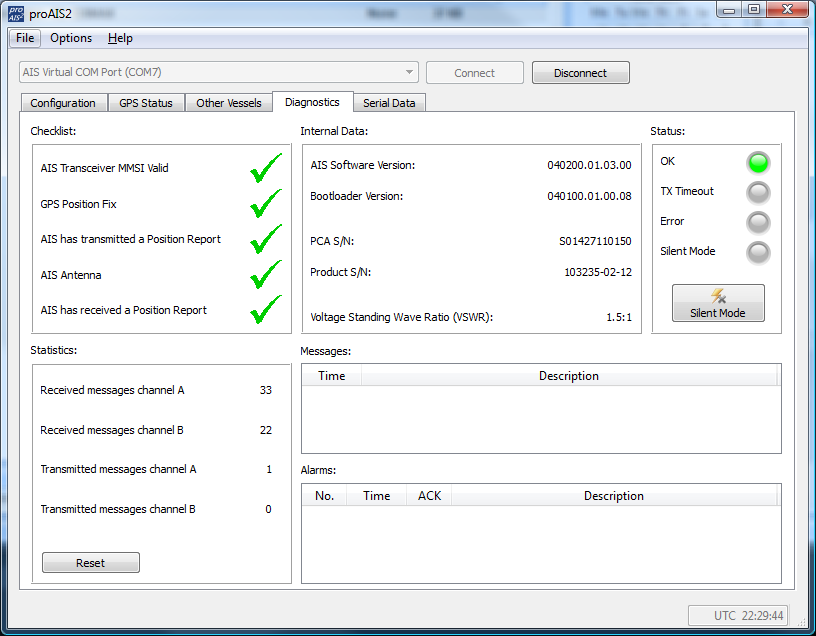
A- Check if your AIS receives a good GPS position.
Without a good GPS fix, an AIS transponder cannot transmit correctly your position. By going to the GPS Status tab in ProAIS2, you can see the GPS reception. If you have one of our AIS transponder with built-in GPS antenna, then you should consider installing a GPS booster (for more information, click here ).
If you have an external GPS antenna then make sure that the connectors are correctly tight and also that the antenna is outside and has a clear view over the sky.
B- Check the VHF antenna
In the Diagnostics Tab in ProAIS2 or within the iAISTX/AIT5000 web interface, you can see the VSWR ratio. The VSWR ratio is explained in the FAQs. If your VSWR ratio is above 3, then you must check the VHF antenna connectors and the cable.
If possible, use another VHF aerial to check if the AIS transmits better.
C – Check that all the data have been entered
In the Configuration Tab in ProAIS2, you must make sure that all the boat details have been added (MMSI, VHF Call Sign, Name, Dimensions, etc.)
You can send us via email a screenshot of the ProAIS2 diagnostics tab or your iAISTX/AIT5000 web interface, we will then let you know whether the product works well or not.
I cannot display AIS targets
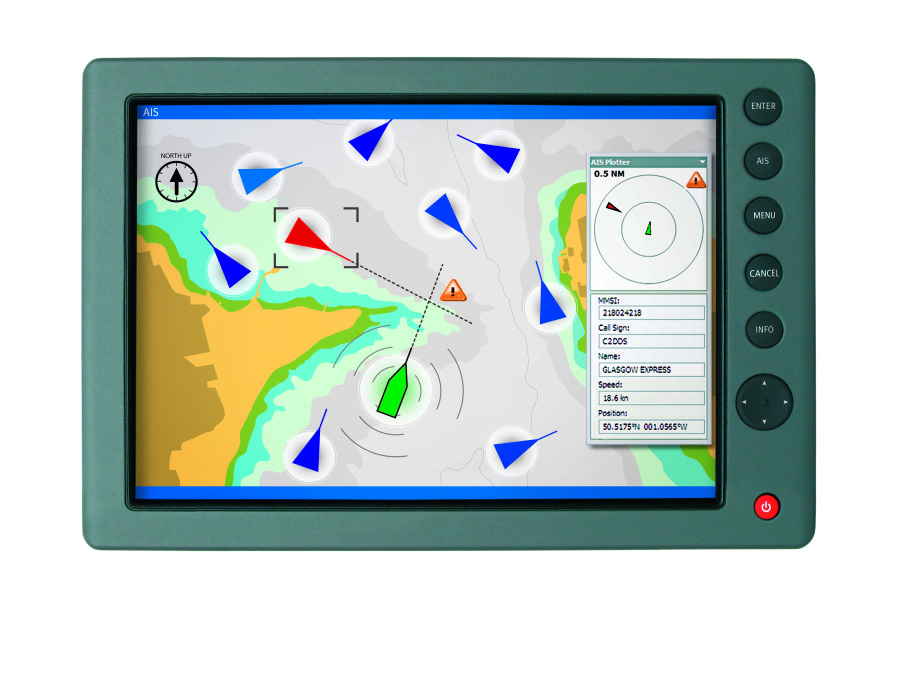
If you encounter an issue with AIS showing on your display (navigation software or chart Plotter) then you should follow this procedure.
1 – Issue with a Chart Plotter/VHF Radio
If you cannot display AIS targets on your Chart Plotter or VHF radio, then follow this:
- If you have connected your AIS to your Chart Plotter/VHF Radio via NMEA 0183 wires , then you must make sure that you have used the NMEA 0183 38400 baud wires (Orange + & Brown – for Digital Yacht AIS Transponders). The second step is to check your Chart Plotter / VHF Radio settings. The best solution here is to check your product manual but you must make sure that the NMEA 0183 port is set at 38400 baud and also that AIS targets are activated.
- If you have connected your AIS to your Chart Plotter/VHF Radio via NMEA 2000 , then you must make sure that the NMEA 2000 network is working properly. This page might answer to your question. You should also make sure that AIS targets are activated in your chart plotter / VHF radio settings.
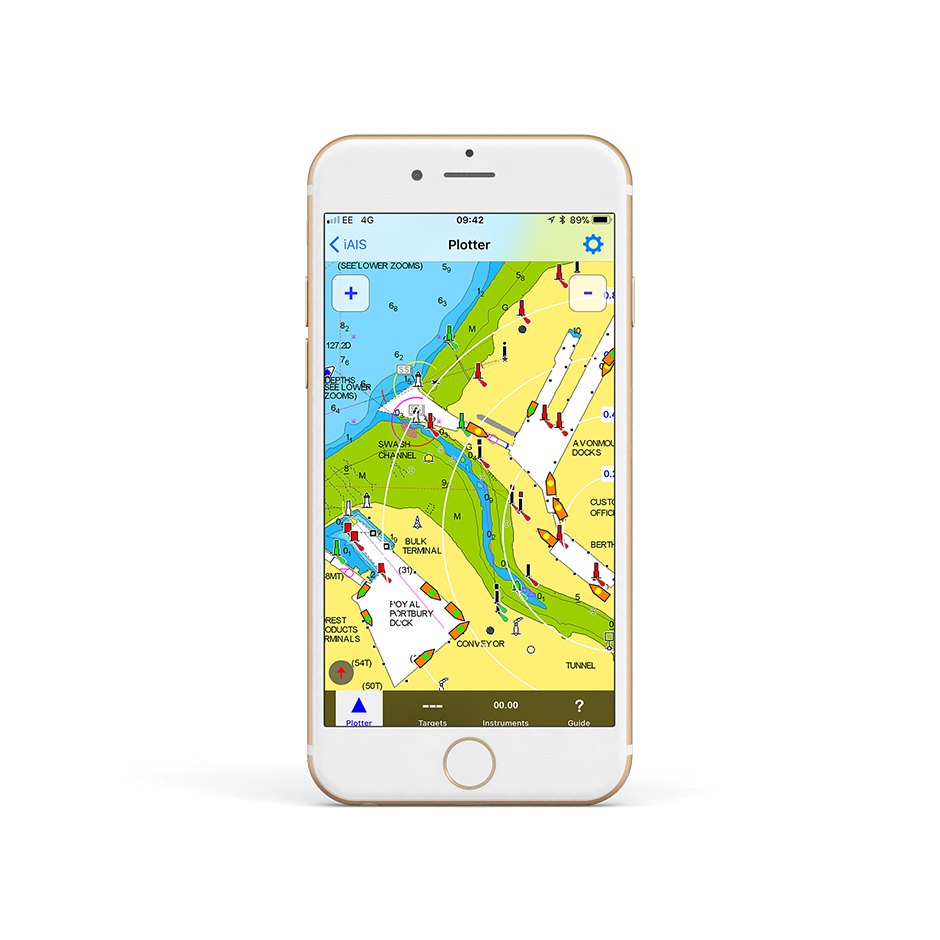

- Communications
- WiFi, 3G/4G & Networks On-Board
- NMEA Adaptors, Connectors & Cable
- Sensors & Transducers
- Wind Generators & Accessories
- Solar Panels & Regulators
- LED Navigation Lights & Bulbs
- LED Interior Lights & Bulbs
- Circuit Distribution
- Circuit Protection & Control
- Shore Power
- Alternators, Regulators & Accessories
- Batteries Charging & Battery Accessories
- Hydrogenerators
- Rigging Hardware
- Winches & Accessories
- Clutches, Cleats & Jammers
- Organisers, Footblocks & Guides
- Lines, Ropes & Accessories
- Shackles, Snapshackles & Hooks
- Furling Systems
- Anchoring & Mooring
- Skin Fittings & Seacocks
- Switches, Sensors & Alarms
- On Board Plumbing
- Engine & Fuel
- Personal Equipment
- Epoxy Resin, Fibreglass & Fillers
- Hand-Held VHF Radios
- Fixed VHF Radios
- Hand-Held VHF Accessories
- Fixed VHF Accessories
- Antennas & Mounts
- Cables and Connectors
- Receivers & Transponders
- AIS Antennas & Mounts
- GPS Receivers
- Electronic Compass
- Marine Wind Generators
- Wind Generator Parts & Accessories
- Marine Solar Panels & Accessories
- Solar Regulators & Displays
- MPPT Solar Regulators
- Optolamp LED Navigation Lights
- Lunasea LED Navigation Bulbs
- Interior LED Bulbs
- Interior LED Lights
- Interior CCFL Lights
- Cable & Terminals
- Cable Glands
- Adhesive Lined Heat Shrink
- Switches & Selectors
- Circuit Breakers
- Meters and Gauges
- Fuses & Fuse Blocks
- Stainless Steel 316 Rigging Wire
- Cable Terminals
- Rigging Screws & Tensioners
- Rigging Tension Gauges
- Backstay & Babystay Tensioners
- Deck & Mast Fittings
- Andersen Winches
- Harken Winches
- Ronstan Orbit Winches™
- Spinlock Rope Clutches & Cleats
- Spinlock Parts & Accessories
- Rutgersen Rope Clutches
- Rutgersen Parts & Accessories
- Harken Carbo AirBlocks 29 mm - 75 mm
- Ronstan Orbit Blocks™ 30 mm - 55 mm
- Lewmar Synchro Blocks 50 mm - 90 mm
- Ronstan Core Blocks 45 mm - 100 mm
- Selden Plain Bearing Blocks 50 mm - 100 mm
- Harken Cruising ESP Blocks 57mm - 100mm
- Soft / Low Friction Blocks & Rings
- Gleistein Ropes
- Tylaska Snapshackles
- Code Zero & Gennaker Furlers
- Jib/Genoa Furling Systems
- McMurdo 406Mhz EPIRB Emergency Beacons
- McMurdo 406Mhz PLB Emergency Beacons
- Spinlock Lifejackets
- Plastimo LifeJackets
- Lifejacket Spares & Accessories
- Brands 3M Actisense AMC Oceanflex® Ancor Andersen Ankarolina Anza Auto Marine Cables BEP Marine Blue Sea Systems Blue Sky Energy Blue Wave Boa Can-SB Carling Technologies Century Hoses LTD. Chafe Pro Clamcleat Clyde Marine Leather Cobra D-Splicer Digital Yacht DSL Duralac Durite Effebi Facet FastFind Flojet ForeSpar Genasun Gleistein Glomex Guidi Harken HILLTOP Hubbell Icom International Isiflo Isis JCS Kong Led Lenser Lewmar Littlefuse Loos & Co Lunasea Maestrini Marco Marinebeam Marineco Mast Mastwalker McMurdo Metz Morningstar Nautllus O-Wave Ocean Ocean Technologies Optolamp Osculati Pela Plastimo Primus Windpower Proboat PSP Marine Tapes Remoran Ronstan Rutgersen ScanStrut Selden Selma Shakespeare Sikaflex Silentwind Simarine Solara Solbian Speedfit Speedy Stitcher Spinlock SPXFlow Johnson Pump SSB Stadea Standard Horizon Sterling Power Suncor Sunware Sutars Swobbit Talurit Teak Decking System Toollogic Trem Tylaska Uflex Ultra Marine Victron Energy
- Info Radio Beacon Registration DGAC VHF Regulations (Spanish) Reglamento de Luces (Spanish) Qúe es DSC (Spanish) Andersen Winch Selection Guide Andersen Winch Weight Comparison Chart
- AIS Personal Emergency Beacons
- Jacklines, Lifelines & Tethers
- Boom brakes
- AMC Oceanflex®
- Auto Marine Cables
- Blue Sea Systems
- Blue Sky Energy
- Carling Technologies
- Century Hoses LTD.
- Clyde Marine Leather
- Digital Yacht
- International
- Loos & Co
- Morningstar
- Ocean Technologies
- Primus Windpower
- PSP Marine Tapes
- Shakespeare
- Speedy Stitcher
- SPXFlow Johnson Pump
- Standard Horizon
- Sterling Power
- Teak Decking System
- Ultra Marine
- Victron Energy
- Radio Beacon Registration
- DGAC VHF Regulations (Spanish)
- Reglamento de Luces (Spanish)
- Qúe es DSC (Spanish)
- Andersen Winch Selection Guide
- Andersen Winch Weight Comparison Chart
Digital Yacht AIT2000 Class B AIS Transponder
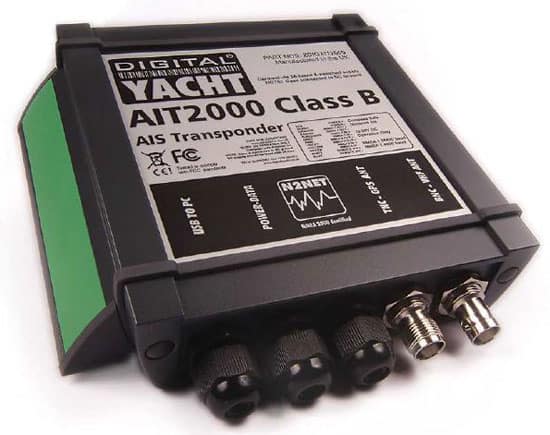
- Description
- Product Variations
- Parts & Accessories

Multiple Input / Output Options - The ultra-compact AIT2000 Class B Transponder has three output options built-in. NMEA 0183, NMEA 2000 and USB connection, allowing it to work with every AIS compatible chart plotter or software package on the market today.
Dual NMEA 0183 Inputs and Outputs - The AIT2000 can receive both 4800 and 38400 baud rate inputs. This data is then multiplexed with the AIS data and output via the NMEA output 1 at 38,400 or the USB cable. NMEA output 2 transmits GPS data at 4800 baud perfect for a DSC VHF or instrument system.
Remote Silence Switch Option - By adding a simple remote toggle switch (not included) the transmit function of the AIT 2000 can be turned off when not required. A waterproof switch can be installed in the cockpit.
Built-in 50 channel GPS receiver - Output GPS date via NMEA 2000, USB or NMEA0183, the supplied GPS antenna is designed to be fitted to a standard 1” x 14 TPI threaded pole mount
Windows and Mac proAIS2 Software Included - Configuration of your vessel’s fixed data, such as MMSI, call sign, boat name, dimensions etc. is made easy with the included Windows and Mac compatible proAIS2 software. Once configured, the unit will provide AIS data to a PC or Mac running suitable navigation software or a dedicated chart plotter, such as the latest Garmin, Raymarine, Navico, Standard Horizon and Furuno units.
- Suitable for both 12v and 24v systems
- Latest generation AIS technology – brand new AIS transponder (Class B) design
- Ideal for use with existing plotter and radar systems
- Built-in high performance 50 channel GPS receiver (ideal also as a backup GPS)
- USB Interface for simple plug and play connection to a PC or Mac
- Includes N2Net interface and cable for connection to NMEA 2000 network
- High speed NMEA (38,400 baud) – compatible with industry standard plotters
- Comes complete with GPS antenna with integral 1”x14TPI thread mount
- Requires dedicated VHF/AIS antenna or splitter (SPL250)
- Remote Silence Switch option
- Easy to install black box solution

Digital Yacht AIT2000 Installation Manual EN (552 Kb) - Download
Digital Yacht AIT2000 Manual de Instalación ES (664 Kb) - Download

- Product Details
- Parts & Accesories
- Create account
- Recover password
- Saved for later
bluemarinestore
- Shipping Costs
- Shipping Restrictions
- Prices & VAT / Taxes
- Canary Islands, Ceuta & Melilla
- Product Returns
Blumast S.L.
- Terms & Conditions
- Data Protection & Privacy
- Your comments
- Google Business
- Follow us on Facebook
- Follow us on Twitter
- Follow us on Youtube
© 2009 - 2024 bluemarinestore. All Rights Reserved
Cookies are used on our website to provide functionality and to improve user experience. Some cookies are essential for our website to function correctly. By continuing to use our site, you are agreeing to the use of these cookies in accordance with <a href="https://www.bluemarinestore.com/our-cookie-policy/">Our Cookie Policy.</a> Other types of cookie are optional, you can manage your consent choices now or at any time in the future by clicking on the link below.
Analytical cookies are used to assess the performance of our website, to improve functionality, offer the right products and enhance the user experience. See Our Cookie Policy for further information.

AIS SYSTEMS
Internet on board, nmea interfaces, pc on board, portable navigation.
- AIS Transponders
- AIS Receivers
- VHF Splitters & Antennas
- AIS Accessories
- Antenna Mounts
- Multisensor
- NMEA to WiFi
- NMEA Interfaces
- NMEA 2000 Cables
- SeaTalk Interfaces
- USB Converters
- 4G/5G Internet Access
- Hi Power Long Range Wifi
- Cables & Accessories
- PC Accessories
- TV Antennas
- PC Software
- iPhone & iPad apps
- Android Apps

AIS SOLUTIONS
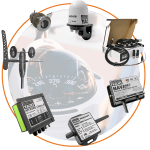
INSTRUMENTS SOLUTIONS

INTERNET SOLUTIONS
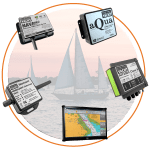
NAVIGATION PC SOLUTIONS
- Technical FAQs
- How to configure AIS
- How to configure our 4G products
- How to create an NMEA 2000 network
- How to configure apps & software
- WLN10 & WLN30
- Products with NMEA 2000 interface
- Get Support
- Product Registration
- Product Return Form
Username or email address *
Password *
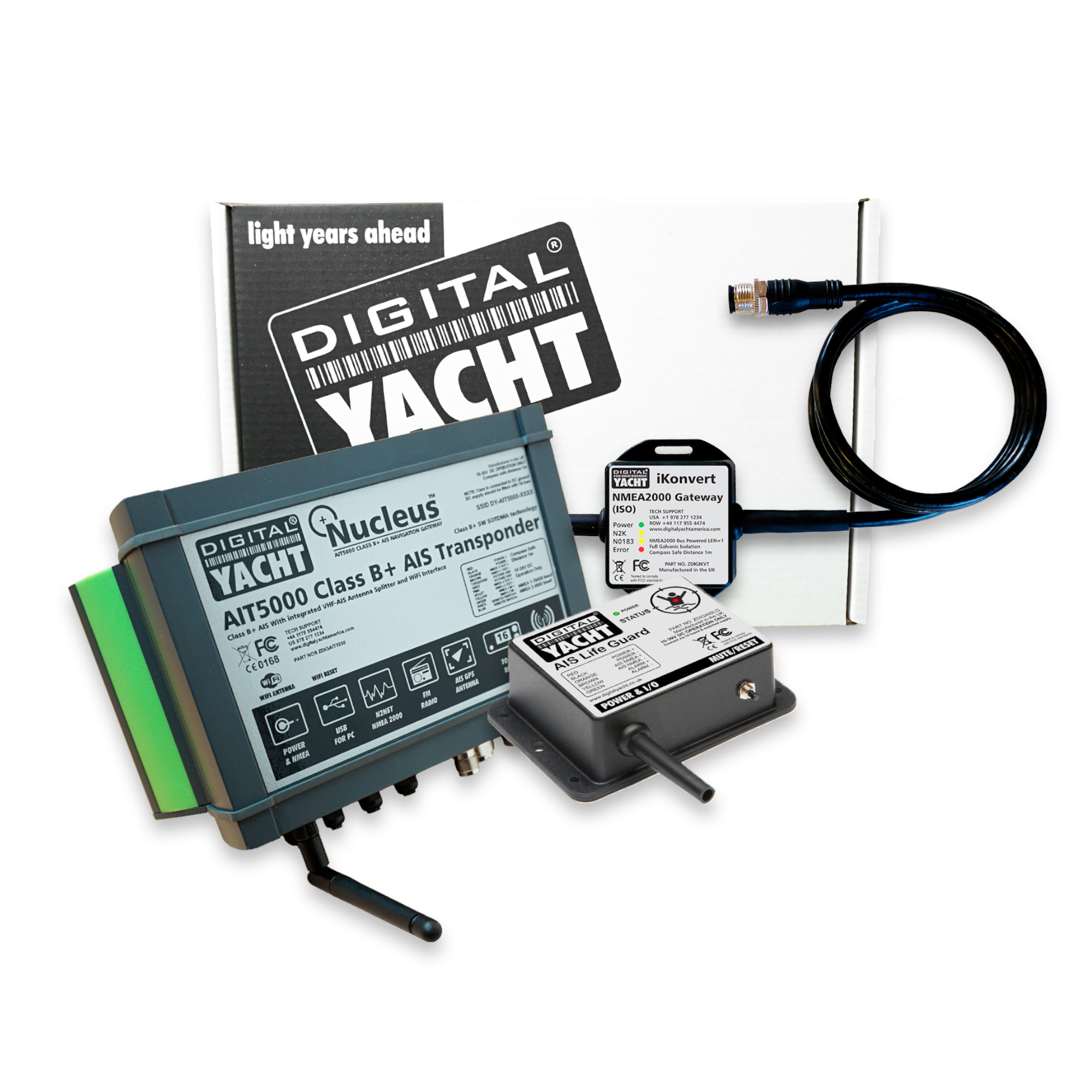
AIS Transponder with Alarms, VHF Splitter, WiFi & NMEA2000
From: $ 2,400.00 ex GST
“The perfect all-into-one pack to receive AIS and to transmit your position as well as streaming wirelessly all your navigation data on navigation apps & software. This pack also includes AIS alarms and a ZeroLoss VHF splitter.”
- Description
- Additional information
- Manual and Downloads
WHAT IS INCLUDED
This package combines an AIS transponder with alarms. Products include:
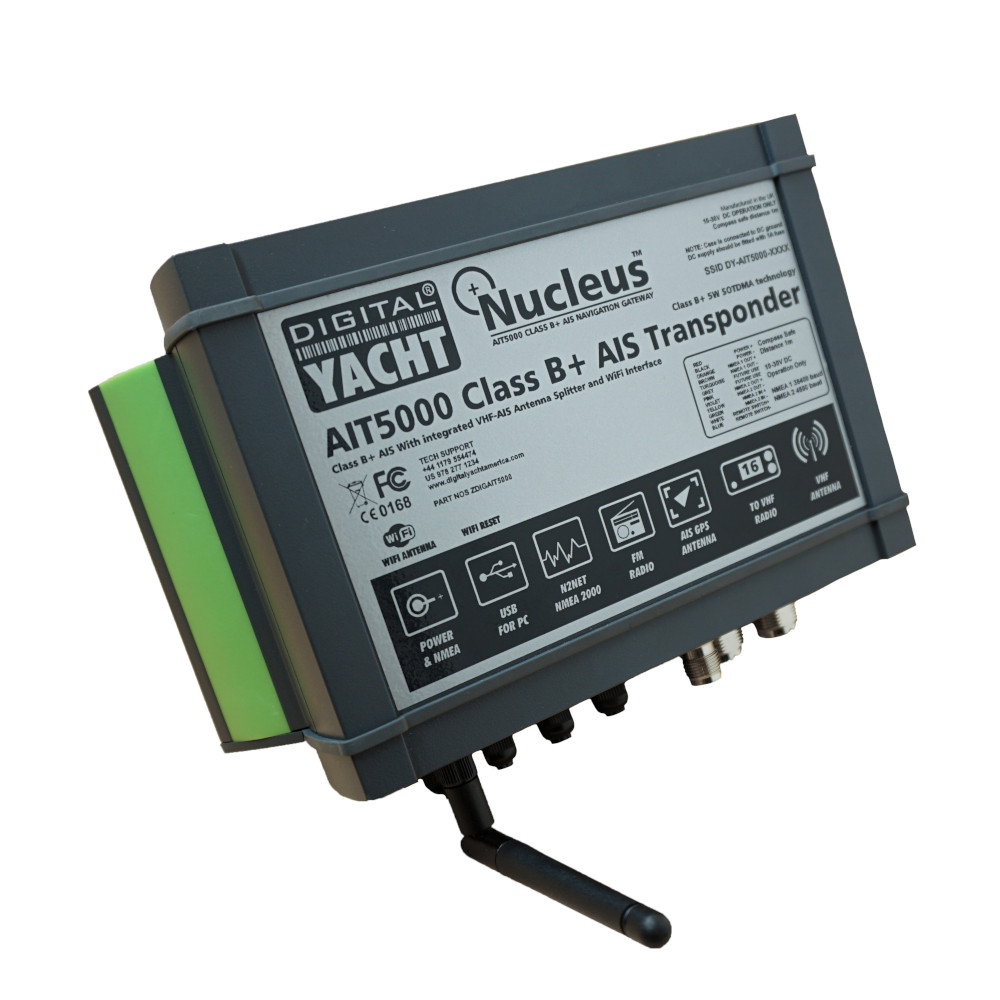
AIT5000 – Class B+ 5W AIS Transponder with built-in WiFi and VHF Splitter
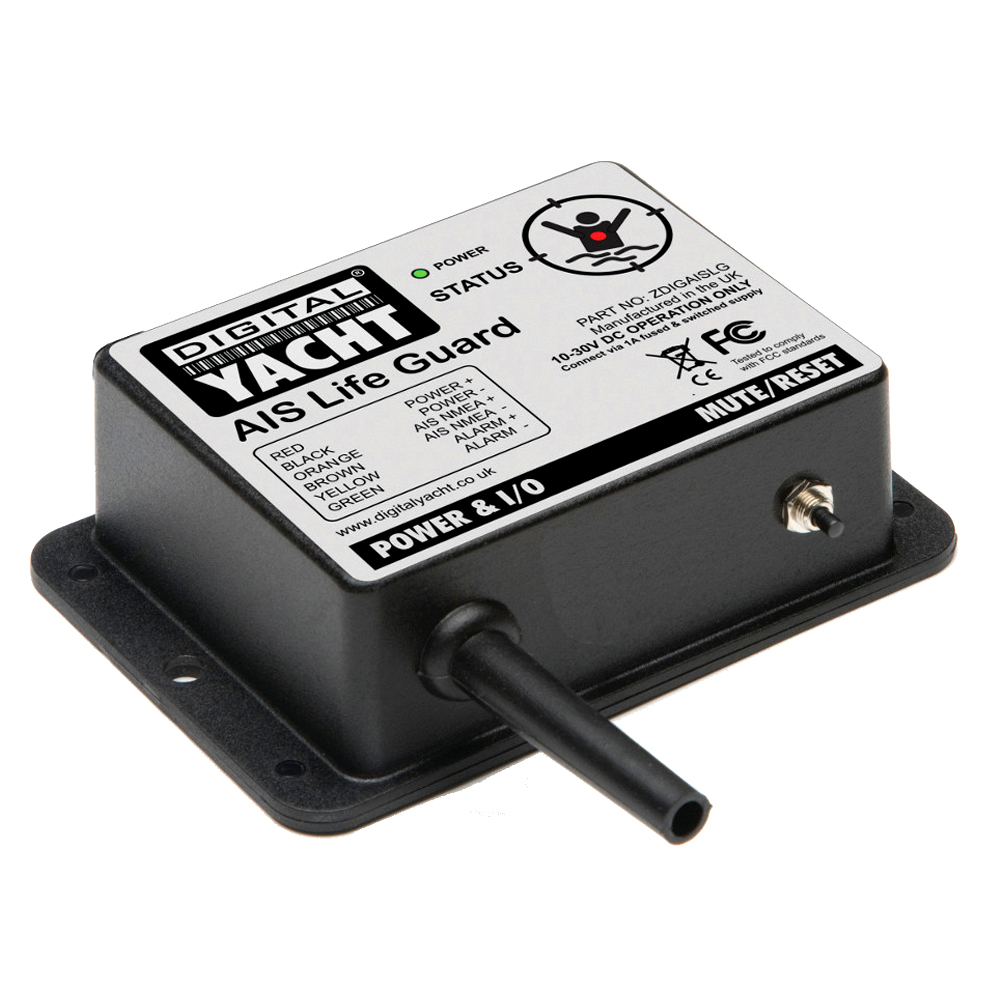
AIS Life Guard – Man Overboard AIS Alarm
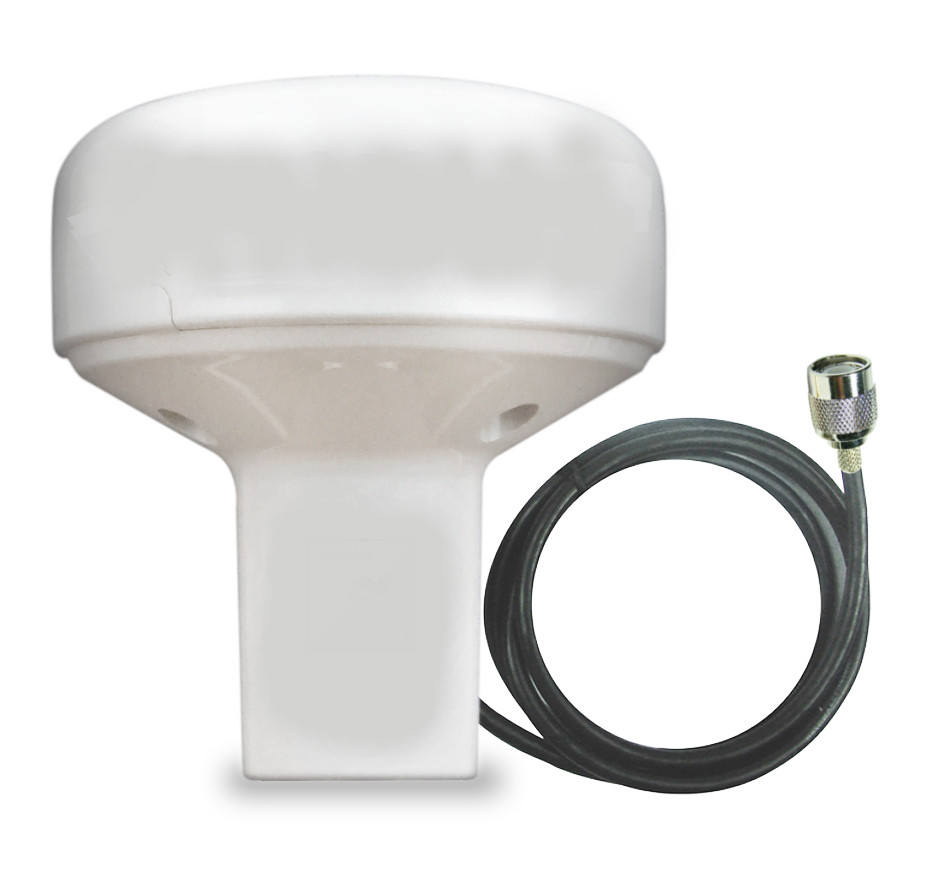
GPS Antenna

In option: iKonvert, NMEA0183/2000 converter

KEY FEATURES
The perfect all-into-one pack to receive AIS and to transmit your position as well as streaming wirelessly all your navigation data on navigation apps & software. This pack also includes AIS alarms and a ZeroLoss VHF splitter.
The AIT5000 “Nucleus” Class B+ 5W AIS incorporates not only a full function Class B+ AIS transponder but also an antenna splitter allowing the main VHF antenna on the boat to be shared with the AIS and VHF. It’s design also incorporates the latest interfacing capability including NMEA 0183, NMEA 2000, USB and a WiFi server to allow tablets and iPads to connect. The NMEA interface allows connection to any AIS compatible chart plotter and USB is available for MAC or PC users as well as allowing programming of the unit with your boat details.
The AIT5000’s wireless interface transmits AIS, GPS and NMEA 0183 data to all the popular navigation apps and software. The wireless interface can connect up to 7 devices and supports both UDP and TCP/IP protocol. Moreover, if you want the wireless interface to also transmit your NMEA 2000 data from your NMEA 2000 backbone, please choose the option with iKonvert which is an NMEA 2000 to NMEA 0183 converter. iKonvert allows for new NMEA2000 equipment to talk to legacy NMEA0183 equipment. Conversions are bi-directional.
The AIS Life Guard is the world’s first Man Overboard AIS alarm designed to work with the AIS SARTs & MOBs. Operation is automatic. Simply connect the two wire NMEA input on the AIS Life Guard to the NMEA output of the AIT5000 and it will listen to all AIS traffic. Upon detecting an AIS SART or MOB transmission (message 1 and message 14), the AIS Life Guard will sound its internal 95dB alarm and display a red warning light.
SPECIFICATIONS
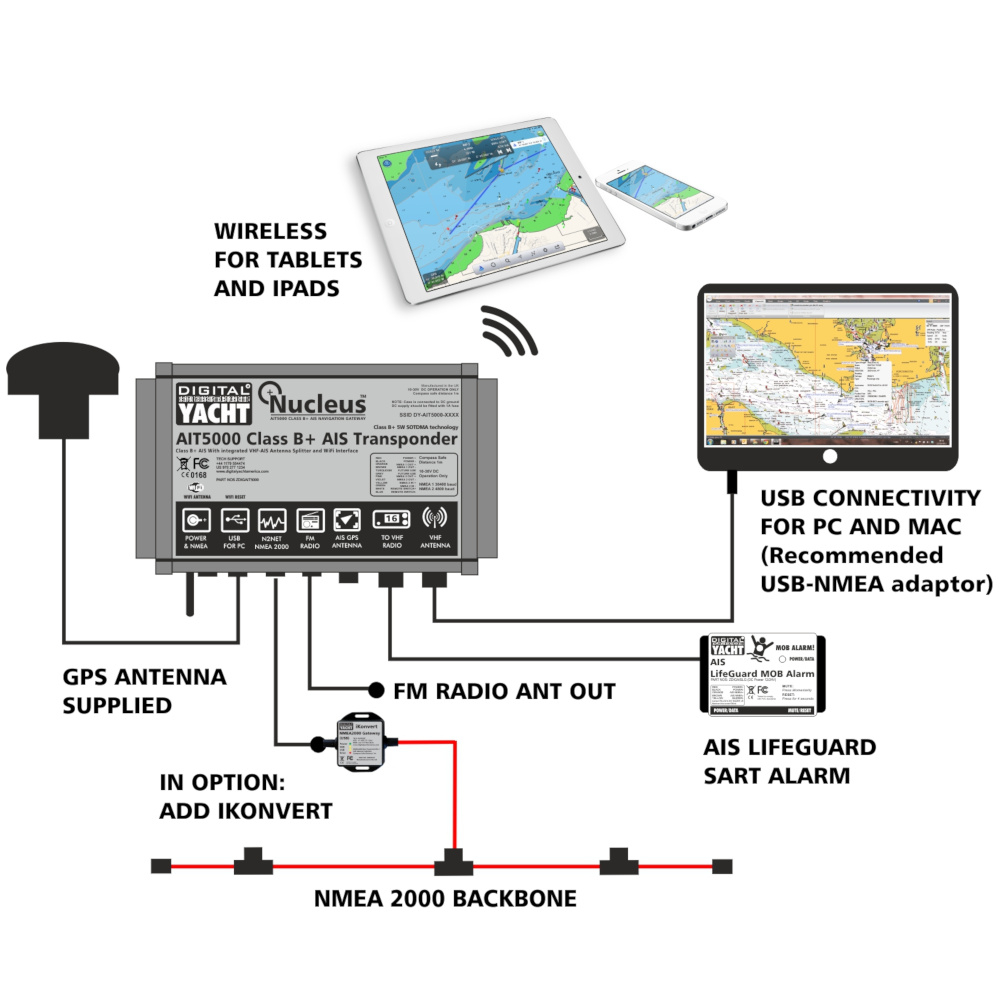
- AIS Transponder with Alarms, VHF Splitter, WiFi & NMEA 2000 connectivity
- In option: Add iKonvert for the AIT5000’s wireless interface to also transmit all the NMEA2000 data
- AIT5000 is a Class B+ 5W transponder with GPS/GLONASS positioning
- Integrated and patented ZeroLoss VHF-AIS antenna splitter (share the main VHF antenna)
- Multiple NMEA 0183 in/out and multiplex capability
- WiFi supports up to 7 wireless devices (UDP & TCP/IP protocol)
- Compatible with all popular software & apps like iNavX, TimeZero, Weather 4D, Navionics, SailGrib, NavLink , iSailor, SeaPilot, AquaMap etc
- AIS Life Guard is a Man Overboard AIS alarm
- It triggers a 95dB alarm upon detecting AIS SART or MOB message 1 and 14
You may also like…

AIS LIFE GUARD
- Automatic Identification System (AIS)
- Navigation sensors
- Internet on board
- Portable Navigation
- NMEA to Wi-Fi Servers
- 4G Internet Access
- Accessories
- Entertainment
- MAC Software
- Connectors + Adapters
- PC Navigation
- Internet Access
- Product Manuals
- Product Firmware
- Technical Notes
- Utilities and tools
- Software and utilities
- USB drivers
- How to configure our AIS
- How to configure apps & software
- WLN10/WLN30
- Login / Register
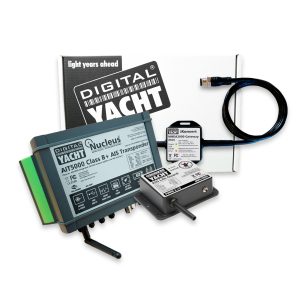

- Digital Yacht
Username or email address *
Password *
Lost your password? Remember me

AIT5000 – Class B+ AIS Transponder with Wi-Fi, NMEA & VHF Splitter
$ 1,299.95
“The AIT5000 is a Class B+ AIS Transponder with a 5W power output, a Wi-Fi interface, a built-in VHF splitter and utilises SOTDMA format transmissions.”
- Description
- Additional information
- Manual and Downloads
- what inside box
- Product Video
KEY FEATURES
Digital Yacht have introduced a new range of Class B+ AIS transponders. Class B+ , a new standard, utilises SOTDMA format transmissions which offer a 5W power output (2.5x more powerful than a regular Class B), a guaranteed time slot for transmission in busy traffic areas and faster update rates depending upon the speed of the vessel. It’s ideal for ocean sailors requiring the best possible performance and future proof satellite tracking applications. As well as fast power boats and smaller non-mandated commercial vessels. It still inter-operates with existing Class B and Class A systems.
The main VHF antenna can be shared with the VHF, AIS and FM radio due to the patented ZeroLoss VHF-AIS antenna splitter incorporated within the AIT5000. furthermore, it also has a wireless interface for connecting to iPads, smartphones and tablets.
The AIT5000 creates a secure, password protected, local Wi-Fi network which allows AIS and GPS data to be sent to popular iOS and Android apps such as Navionics, iSailor, Weather4D, SailGrib, iNavX, TimeZero and more. These apps offer a detailed overlay of local AIS targets all updated in real-time. Depending upon the app, you can click on a target and can see identity as well as collision avoidance data. This includes CPA (closest point of approach) and TCPA (time to closest point of approach).
The tablet’s browser (Safari, Chrome, etc.) provides a simple, embedded web interface for one time programming of the boat’s identity and physical dimensions, required of all AIS transponders. Silencing the transmission and setting up wireless parameters such as passwords can also be done via this web interface.
Moreover, if you want the wireless interface to also transmit your NMEA 2000 data, please add our iKonvert which is an NMEA 2000 to NMEA 0183 converter. The wireless interface can connect up to 7 devices.
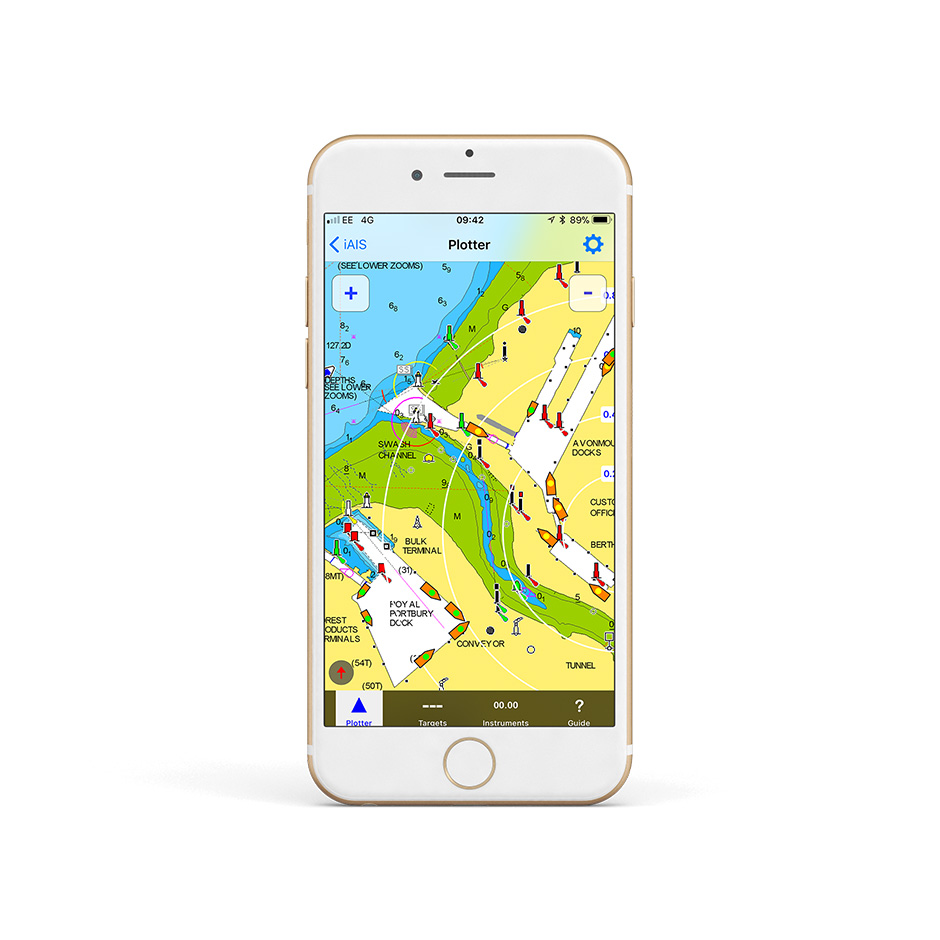
The AIT5000 has t he option of an AIS SART alarm which is great for use with personal AIS MOB devices. Now works with the popular Navionics Boating App for Apple iOS and Android to display GPS and AIS data on your Navionics charts.
CONFIGURATION
In order to facilitate the use and configuration of our AIS transponders, our AIT5000 now has a built-in web interface. The configuration of the transponder can be done through a computer, a tablet or even a smartphone and most importantly, no software is require
You can configure the AIT5000 through its own simple web interface, just open your web browser, enter the AIT5000’s IP address and you can configure the vessel details (MMSI number, Boat name, etc.), network name, password and even merge the AIS’s WiFi to an existing WiFi network on board. So no complicated programming software or app required. You can even view the received NMEA data in the web browser, for easy fault finding of issues.
Finally, the AIT5000 supports TCP and UDP network protocols for maximum compatibility with apps. If you want to have full bi-directional control of an autopilot, with guaranteed data integrity or you want to be the only person receiving the data, then select TCP. If however, you want to receive the same data on multiple devices, for instance a PC at the chart table and an iPad on deck, then select the UDP broadcast protocol.
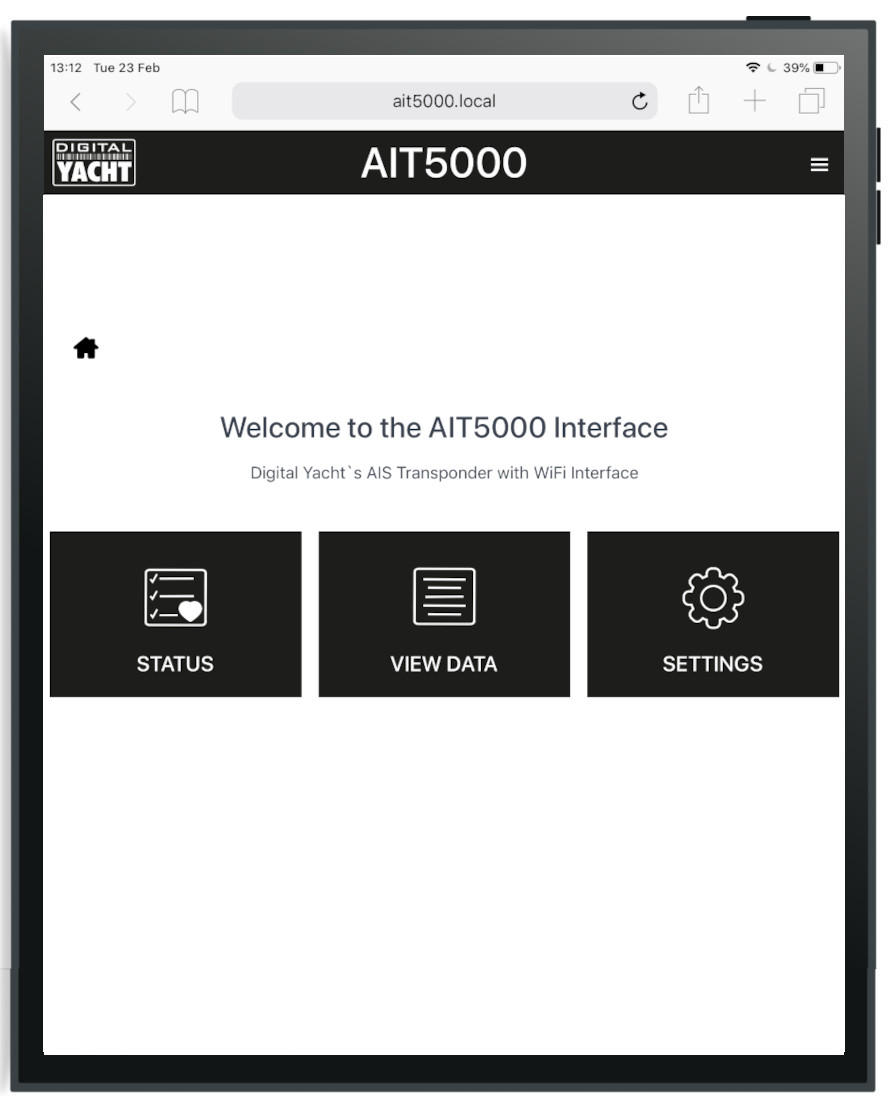
SPECIFICATIONS

- New Class B+ 5W transponder with GPS/GLONASS positioning
- Integrated and patented ZeroLoss VHF-AIS antenna splitter (share the VHF antenna)
- Multiple NMEA 0183 in/out and multiplex capability
- NMEA 2000 connectivity
- USB connectivity for PC/MAC
- Password protected wireless interface for tablets, smartphones and PC
- Web interface for configuration and status monitoring
- UDP and TCP/IP protocols supported for up to 7 connected devices
- Remote TX silence switch option
- Supplied with GPS antenna
- The AIS all-in-one Nucleus solution
- Alarm option too with AISLifeGuard
AIT5000 Quick Start Manual V2.00
An AIS which sends and receives data is known as a transceiver (or often called a transponder). There are also simple devices called AIS receivers which pick up transmissions and decode for displaying on a compatible chart plotter or PC based navigation system – or even an iPad or tablet.
AIS transponders will allow you to receive data from vessels close to you, but will also allow you to continuously transmit your vessel’s identity, position, speed and heading, as well as other relevant information, to all other AIS-equipped vessels within your range.
To transmit its position, an AIS transponder must have its own GPS antenna. All our AIS transponders are supplied with a GPS antenna or have a built-in GPS antenna.
To help you choose the right AIS transponder for you, here are a few keys that may help you out:
- Receive targets on a plotter – if you want to receive only AIS targets on a plotter then you have the choice between the AIT1500, AIT1500N2K, AIT2000 and AIT2500. The AIT1500 or AIT1500N2K have a GPS built into the transponder and is therefore recommended for fibreglass boats up to 30 feet. The AIT1500 only has an NMEA 0183 interface while the AIT1500N2K has a NMEA 2000 interface. The AIT2000 (class B) and AIT2500 (class B+) both have an external GPS antenna and can therefore be installed on any type of boat. They both also have an NMEA 0183, NMEA 2000 and USB interface.
- Receive AIS targets on software or applications – If you only want to receive AIS targets on navigation software or applications, then we recommend the iAISTX. This is an AIS transponder with an external GPS antenna and a built-in WiFi server.
- Receive AIS targets on a plotter AND software/applications – To receive AIS targets on a plotter and software/applications at the same time, we recommend the AIT5000 (Class B+). The AIT5000 is the most complete AIS transponder with a certified zero loss VHF antenna splitter, NMEA multiplexer, external GPS antenna and WiFi server.
- AIS for rental boats – if you are looking for an AIS receiver or transponder that you can put in your suitcase and want to use when renting a boat then the Nomad is the right AIS transponder for the job. It is the only portable AIS transponder that has a built-in GPS, is USB powered and comes with a portable VHF antenna.
Now that you have an idea of which AIS transponder you need, you will also need to choose between Class B or Class B+ AIS transponder.
There are 3 types of AIS transponders: Class A, Class B and Class B+ :
- Class B AIS Transponder is for recreational craft installation and is a simplified, lower powered 2W transceiver which is normally a black box and uses a connected chart plotter to display local AIS targets. It transmits every 30 seconds regardless of vessel speed and can’t transmit additional data like destination port.
- Class B+ AIS Transponder (also called Class B SOTDMA or Class B 5W ) is a new standard that utilises SOTDMA format transmissions which offer a 5W power output (2.5 x more powerful than a regular Class B), a guaranteed time slot for transmission in busy traffic areas and faster update rates depending upon the speed of the vessel. It’s ideal for ocean sailors requiring the best possible performance and future proof satellite tracking applications, fast power boats and smaller non-mandated commercial vessels.
- Class A AIS Transponder must have a dedicated (and type approved) display to show the location of nearby AIS targets and transmits at 12.5W. Data is sent at up to every 2 seconds depending upon the vessel speed and the display also allows for data to be inputted to the transmission such as vessel destination. A Class A device is normally used on commercial vessels as its Type Approved to IMO specifications.
In order to facilitate the use and configuration of our AIS transponders, our new AIS transponders now have a built-in web interface. This is the case for the iAISTX, iAISTX Plus and AIT5000. These devices create a WiFi network on board and configure themselves by connecting to WiFi. The configuration of the transponder can therefore be done through a computer, a tablet or even a smartphone and most importantly, no software is required.
The following article explains you how to configure the AIS transponder: https://digitalyacht.net/2020/02/28/configure-ais-transponder-web-interface/
If you want to stop transmitting your position, you can either fit a physical silent switch on the AIS transponder or you can stop the AIS transmission through the ProAIS2 software.
You can stop the AIS transmission of our iAISTX & AIT5000 with their built-in web interface. Easy to stop the AIS transmission with your smartphone.
This is a very valid question. Especially if you have spent a few hours installing the transponder then knowing that it is working OK is very important. Using the proAIS2 configuration software allows you to see if the GPS position is OK. You can monitor the AIS reception of other vessels. As well as ensure that there are no errors or alarms. However, if you are new to AIS, there is always that nagging doubt as to whether other vessels are seeing you.
The best test of a Class B transponder is to ask someone else in your marina, who has AIS, to check that they are receiving you on their system. If your vessel is stationary, then a transponder will only transmit every 3 minutes. This increases to every 30 seconds when your speed over the ground (SOG) is greater than 2 knots. Therefore, do allow some time for them to detect you. Also when they first receive your transmission, the only data they will see is your position, speed, course and MMSI number. It can take up to 6 minutes to receive your “Static Data” (boat name, call sign, vessel type, dimensions, etc.). This is normal and is the way the AIS system regulates the amount of data being transmitted.
The other increasingly common method of testing an AIS transponder is to look on one of the online “live” AIS websites and the most popular of the free services is MarineTraffic.com
However, it is important for you to be aware of the limitations of these online sites. As a result, do not assume that you will always be picked up by them. Each of the different online services are only as good as their network of AIS receiving stations. In many cases enthusiasts/volunteers operate these. In some areas the coverage is great but there are definitely “holes” in coverage.
Our AIS transponders with a built-in web interface create a password protected WiFi network. With your tablet, PC or smartphone, if you scan for wireless networks, you should see a wireless network called “DY-AIS-xxxx” or “IAISTX-XXXX” where xxxx is a four-digit code unique to your AIS transponder. The name of the WiFi networks might change according to the product version.
Make your device join this network and you will be asked to enter a password which is “PASS-xxxx” where xxxx is the same four-digit code as in your network name. You can change both the network name and password in the AIS transponder unit’s web interface
No internet connection is required. Many consumers get confused and automatically associate wifi with internet. The product creates a wifi network and the local iPad or tablet users searches for this in the same way they search for a wifi hotspot.
Once connected, NMEA data is sent over the local link created on board the boat.
Up to 7 devices can connect using UDP. TCP/IP is a one to one connection format. PCs, MACs, Android, Linux and iPhone/iPad are all compatible.
We keep up to date reviews on our news blog at www.digitalyacht.net – search for Best Marine Apps for Android or iOS. Popular apps include Navionics, iNavX, TZ iBoat , iAIS, NavLink, iSailor, SeaPilot, Weather 4D, MaxSea TimeZero, SailGrib and literally 100s more.
Our products are also compatible with navigation software on PC/Mac/Linux.
We keep on our blog a list which explains how to configure all the popular navigation apps & software. This list explains how to configure a NMEA connection (UDP/TCP) on the app/software but also how to configure the AIS settings.
To see the list, please click here: https://support.digitalyacht.co.uk/how-to-configure-apps-software/
Yes! You can program this through the web interface so you just have one Wi-Fi network on board with our product linked directly to your other Wi-Fi network as a client.
This works well as well with Furuno WiFi radar installations.
The Wi-Fi will typically footprint a boat up to 25m LOA. Contact us if you need a bigger footprint or have a steel or carbon vessel.
- GPS Antenna and 10m cable
- 3dBi WiFi Antenna
- PL259 patch cable for VHF
- 0.8m NMEA 2000 drop cable (male)
- 0.8m NMEA 0183 & Power cable
- 0.8m USB cable
You may also like…
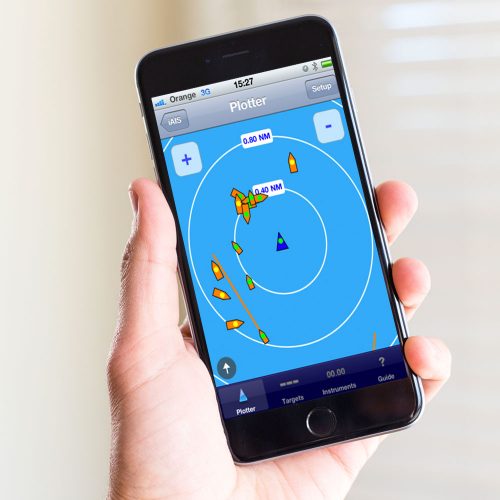
iAIS application
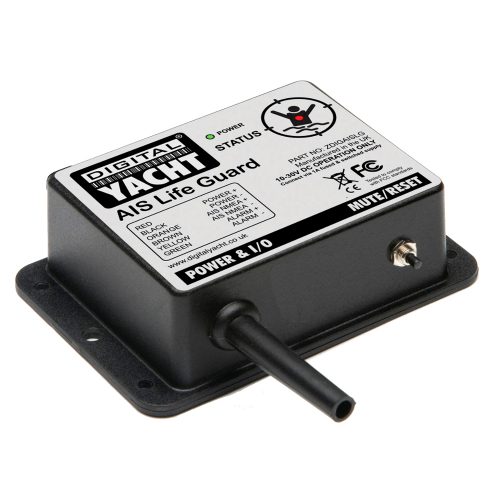
AIS LIFE GUARD

iKonvert – NMEA2000 to NMEA0183 Converter (ISO)
- Automatic Identification System (AIS)
- PC on Board
- Portable Navigation
- AIS Receivers
- AIS Transponders
- VHF Splitters & Antennas
- AIS Beacons
- AIS Accessories
- Multisensor
- NMEA to WiFi Servers
- NMEA Interfaces
- NMEA 2000 Cables
- SeaTalk Interfaces
- USB Interfaces
- 4G/5G Internet Access
- Hi Power Long Range Wifi
- Accessories
- PC Accessories
- TV Antennas
- PC Software
- Android Apps
- Antenna Mounts
- Connectors + Adaptors
- Instruments
- PC Navigation
- Internet Access
- Get Support
- Product Manuals
- Tech Support Notes
- Product Firmware
- Software and utilities
- USB Drivers
- WLN10 & WLN30
- Products with NMEA2000 interface
- How to configure apps & software?
- Product Registration
- General News & Events
- Product Information
- Applications
- Product Pictures
- Product Guide
- Login / Register

We value your privacy
Privacy overview.

- Digital Yacht
Username or email address *
Password *
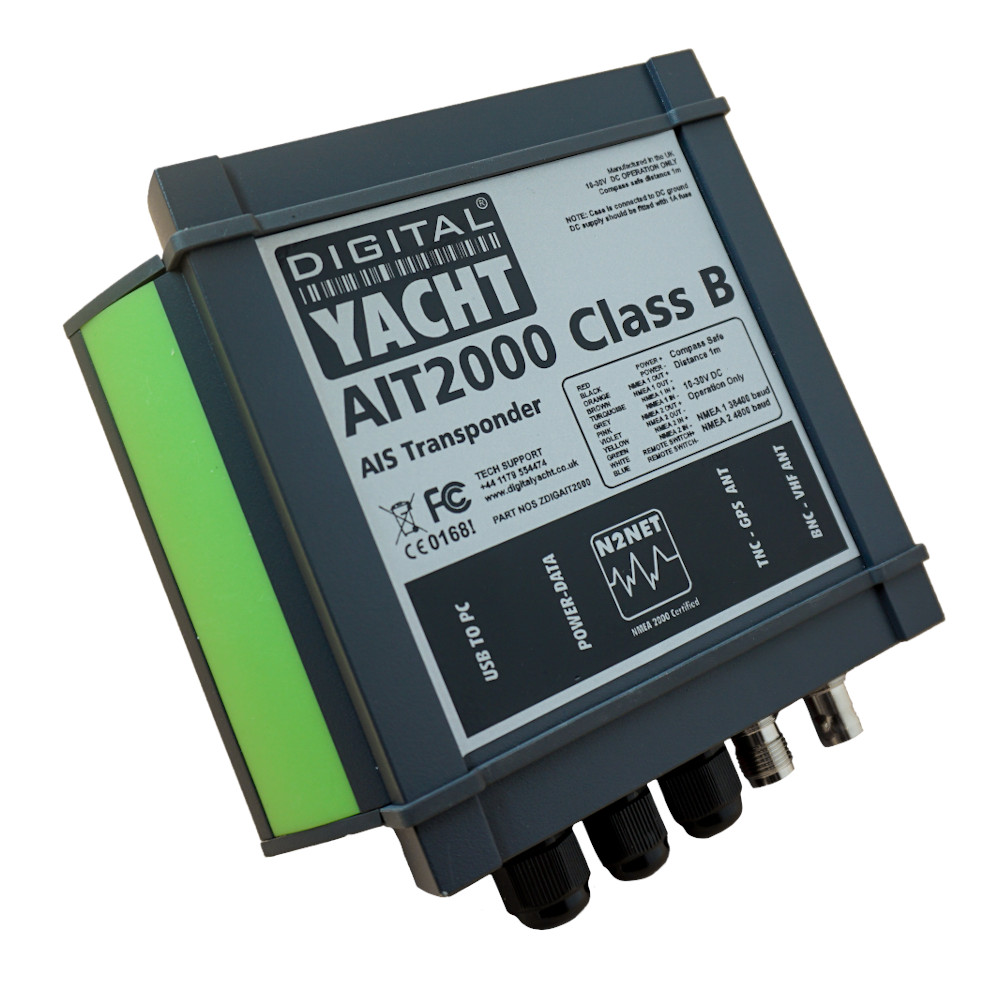
AIT2000 – Class B AIS Transponder
954,00 €
“ Ultra-compact AIS Transponder Class B that uses the latest AIS transponder technology to squeeze more performance and interfacing options with half the size of our previous generation transponder.”
- Description
- Additional information
- Manual and Downloads
- what inside box
KEY FEATURES
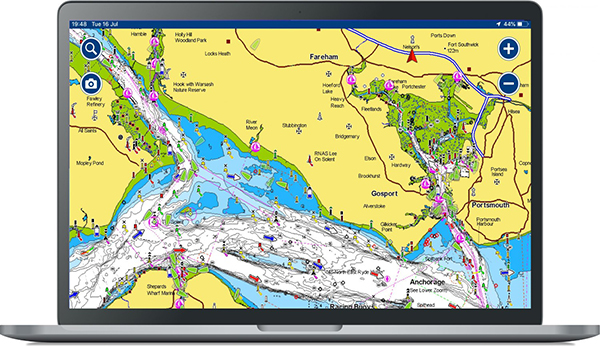
The AIT2000 is an AIS transponder class B. It uses the latest AIS Transponder technology. Therefore squeezing more performance and interfacing options in to a housing that is half the size of our previous generation transponder.
This ultra-compact Class B Transponder has three outputs; NMEA 0183, NMEA 2000 and USB connection, therefore allowing it to work with every AIS compatible chart plotter or software package on the market today. The AIT2000 features a remote silence button option, two NMEA 0183 Inputs and Outputs, four status LEDs and rugged vibration-proof mounting brackets. The AIT2000 is the third generation of Digital Yacht AIS transponder and replaces the very popular AIT1000.
For permanent USB connection to a PC or MAC, we recommend adding one of our NMEA to USB Adaptor cables. Hence providing an extra level of electrical isolation/protection against ground differences and static discharge.
Configuration of your vessel’s fixed data, such as MMSI, call sign, boat name, dimensions etc. is made easy with the included Windows and Mac compatible proAIS2 software*. Once configured, the unit will provide AIS data to a PC or Mac running suitable navigation software or a dedicated chart plotter, such as the latest Garmin, Raymarine, Navico, Standard Horizon and Furuno units.
As well as transmitting your own vessel’s position so that other AIS equipped vessels know where you are, the AIT2000, when connected to an existing VHF antenna (via a splitter) or dedicated AIS antenna, will receive all AIS targets within range of your boat – typically up to 30NM.
With two industry standard NMEA 0183 outputs, our own N2Net connector for plugging in to an NMEA 2000 network and a simple plug and play USB connection to a PC, the AIT2000 is therefore the perfect AIS transponder solution for all light marine vessels up to 300 tons.
For optimum AIS performance on sailing yachts, we also recommend our SPL2000 Splitter featuring “Zero Loss” technology which allows you to use your boat’s existing VHF antenna at the top of the mast for maximum range.
* Except US where dealer programming required
SPECIFICATIONS
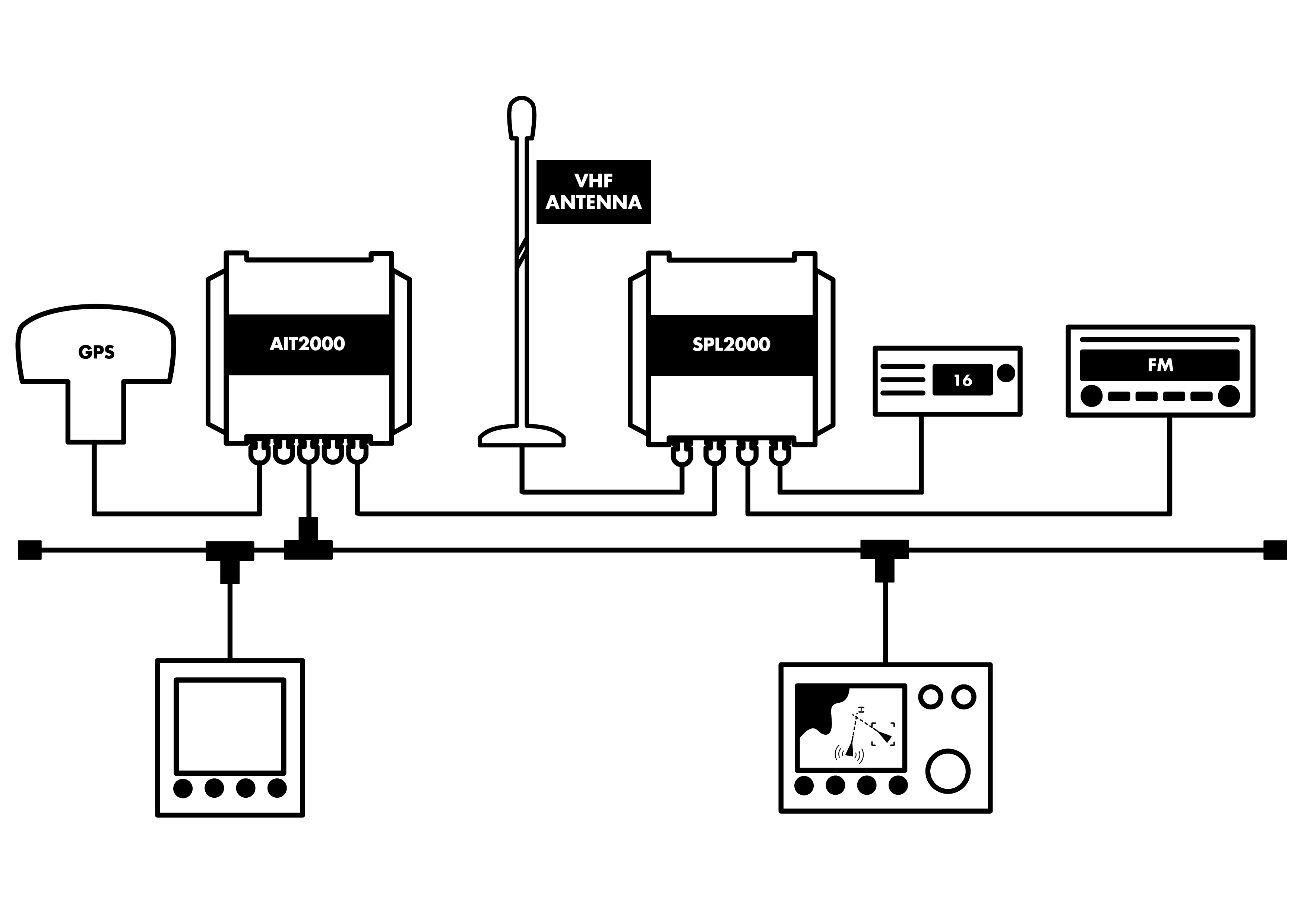
- Latest generation AIS technology – featuring a brand new AIS transponder (Class B) design
- Ideal for use with existing plotter and radar systems
- USB Interface for simple plug and play connection to a PC or Mac
- Includes N2Net interface and cable for connection to NMEA 2000 network
- High speed NMEA output (38,400 baud) – compatible with industry standard plotters
- Low Speed NMEA output (4,800 baud) – for providing GPS data to DSC VHF radio
- Low Speed NMEA Input (4,800 baud) – for multiplexing additional NMEA0183 data
- Comes complete with GPS antenna (10m cable) with integral 1”x14TPI thread mount
- Requires VHF antenna or dedicated AIS antenna (available as optional accessory) or splitter (SPL2000)
- Remote Silence Switch option
- Supplied with programming software for user programming*
- Easy to install black box solution
ProAIS2 V1.20 Mac OSX Zip
Proais2 v1.20 windows zip, ait2000 quick start v2 01 eng pdf.
An AIS which sends and receives data is known as a transceiver (or often called a transponder). There are also simple devices called AIS receivers which pick up transmissions and decode for displaying on a compatible chart plotter or PC based navigation system – or even an iPad or tablet.
AIS transponders will allow you to receive data from vessels close to you, but will also allow you to continuously transmit your vessel’s identity, position, speed and heading, as well as other relevant information, to all other AIS-equipped vessels within your range.
To transmit its position, an AIS transponder must have its own GPS antenna. All our AIS transponders are supplied with a GPS antenna or have a built-in GPS antenna.
To help you choose the right AIS transponder for you, here are a few keys that may help you out:
- Receive targets on a plotter – if you want to receive only AIS targets on a plotter then you have the choice between the AIT1500, AIT1500N2K, AIT2000 and AIT2500. The AIT1500 or AIT1500N2K have a GPS built into the transponder and is therefore recommended for fibreglass boats up to 30 feet. The AIT1500 only has an NMEA 0183 interface while the AIT1500N2K has a NMEA 2000 interface. The AIT2000 (class B) and AIT2500 (class B+) both have an external GPS antenna and can therefore be installed on any type of boat. They both also have an NMEA 0183, NMEA 2000 and USB interface.
- Receive AIS targets on software or applications – If you only want to receive AIS targets on navigation software or applications, then we recommend the iAISTX. This is an AIS transponder with an external GPS antenna and a built-in WiFi server.
- Receive AIS targets on a plotter AND software/applications – To receive AIS targets on a plotter and software/applications at the same time, we recommend the AIT5000 (Class B+). The AIT5000 is the most complete AIS transponder with a certified zero loss VHF antenna splitter, NMEA multiplexer, external GPS antenna and WiFi server.
- AIS for rental boats – if you are looking for an AIS receiver or transponder that you can put in your suitcase and want to use when renting a boat then the Nomad is the right AIS transponder for the job. It is the only portable AIS transponder that has a built-in GPS, is USB powered and comes with a portable VHF antenna.
Now that you have an idea of which AIS transponder you need, you will also need to choose between Class B or Class B+ AIS transponder.
There are 3 types of AIS transponders: Class A, Class B and Class B+ :
- Class B AIS Transponder is for recreational craft installation and is a simplified, lower powered 2W transceiver which is normally a black box and uses a connected chart plotter to display local AIS targets. It transmits every 30 seconds regardless of vessel speed and can’t transmit additional data like destination port.
- Class B+ AIS Transponder (also called Class B SOTDMA or Class B 5W ) is a new standard that utilises SOTDMA format transmissions which offer a 5W power output (2.5 x more powerful than a regular Class B), a guaranteed time slot for transmission in busy traffic areas and faster update rates depending upon the speed of the vessel. It’s ideal for ocean sailors requiring the best possible performance and future proof satellite tracking applications, fast power boats and smaller non-mandated commercial vessels.
- Class A AIS Transponder must have a dedicated (and type approved) display to show the location of nearby AIS targets and transmits at 12.5W. Data is sent at up to every 2 seconds depending upon the vessel speed and the display also allows for data to be inputted to the transmission such as vessel destination. A Class A device is normally used on commercial vessels as its Type Approved to IMO specifications.
If the AIS transponder doesn’t have a built-in VHF splitter (i.e. AIT5000), there are 2 options: either install a dedicated VHF antenna for AIS or install an antenna splitter so that the main VHF antenna is used for both VHF radio and AIS.
For those who want to use their existing VHF antenna, then we recommend the use of a certified zero loss VHF antenna splitter such as our SPL1500 and SPL2000. Please do not use a non-zero loss certified VHF antenna splitter. They are inexpensive, but they can destroy your AIS transponder.
For those who want to install a VHF antenna dedicated to AIS, then we recommend a VHF antenna tuned to AIS frequencies. The AIS transmission and reception works on 2 dedicated channels which use the frequencies 161.975 and 162.025 MHz (channel 87B and 88B). VHF frequencies in the maritime environment use frequencies from 156.0 to 162.025 MHz and most VHF antennas are designed to provide maximum gain on channel 16 (156.8 MHz). You can now find antennas on the market dedicated to AIS frequencies such as the HA156 antenna.
These antennas, dedicated to AIS frequencies, offer maximum gain at 162 MHz (which is the centre between the 2 AIS frequencies 161.975 and 162.025 MHz). So if you install a VHF antenna instead of a VHF antenna splitter for your AIS receiver or transponder, then choose an AIS frequency VHF antenna to compensate for the loss due to the installation of the antenna lower down than the main VHF antenna at the top of the mast. The graph below shows how a dedicated AIS frequency antenna (162 MHz) provides a better VSWR and therefore a better transmission and reception.
The AIS transponder can be configured with the free PC/Mac software called ProAIS2. The ProAIS2 software can be downloaded free of charge directly from our website. The functionality of the proAIS2 software is the same on Windows or Mac.
Installation of the proAIS2 software, also installs the USB drivers and we recommend not plugging the transponders USB cable in to the PC/Mac until after you have installed proAIS2. Once the installation is complete, plug the USB cable in to the computer to complete the USB driver installation. The transponder receives enough power from the USB connection to power the processor and ancillory circuitry required to configure the transponder, however the GPS will not get a fix, the NMEA interfaces will not be working and the transponder will not transmit while on USB power.
Digital Yacht are not the only company that supply proAIS2 with transponders, but to our knowledge, we are the only company to produce a video showing how to configure and diagnose Class B transponders with it. So we hope that not only Digital Yacht users but owners of other brands will benefit from this video.
Please note that the MMSI number cannot be changed once the product has been configured. To change the MMSI number, you must reset the product and for that, please contact us.
To find out how to use the proAIS2 software to configure an AIS transponder, please watch the video below: https://www.youtube.com/watch?v=FTiMynP8KDs
If you want to stop transmitting your position, you can either fit a physical silent switch on the AIS transponder or you can stop the AIS transmission through the ProAIS2 software.
You can stop the AIS transmission of our iAISTX & AIT5000 with their built-in web interface. Easy to stop the AIS transmission with your smartphone.
This is a very valid question. Especially if you have spent a few hours installing the transponder then knowing that it is working OK is very important. Using the proAIS2 configuration software allows you to see if the GPS position is OK. You can monitor the AIS reception of other vessels. As well as ensure that there are no errors or alarms. However, if you are new to AIS, there is always that nagging doubt as to whether other vessels are seeing you.
The best test of a Class B transponder is to ask someone else in your marina, who has AIS, to check that they are receiving you on their system. If your vessel is stationary, then a transponder will only transmit every 3 minutes. This increases to every 30 seconds when your speed over the ground (SOG) is greater than 2 knots. Therefore, do allow some time for them to detect you. Also when they first receive your transmission, the only data they will see is your position, speed, course and MMSI number. It can take up to 6 minutes to receive your “Static Data” (boat name, call sign, vessel type, dimensions, etc.). This is normal and is the way the AIS system regulates the amount of data being transmitted.
The other increasingly common method of testing an AIS transponder is to look on one of the online “live” AIS websites and the most popular of the free services is MarineTraffic.com
However, it is important for you to be aware of the limitations of these online sites. As a result, do not assume that you will always be picked up by them. Each of the different online services are only as good as their network of AIS receiving stations. In many cases enthusiasts/volunteers operate these. In some areas the coverage is great but there are definitely “holes” in coverage.
- 0.75m Power & NMEA0183 Data cable
- 0.75m USB cable
- 0.75m NMEA2000 drop cable
- GPS Antenna and 10m cable
You may also like…

HA156 – VHF Heliflex Antenna
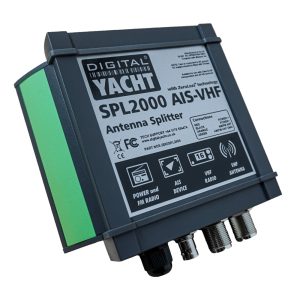
SPL2000 – VHF/AIS/FM Antenna Splitter

GV30 – AIS/VHF/GPS Antenna
- Automatic Identification System (AIS)
- Navigation sensors
- Internet on board
- Portable Navigation
- AIS Transponders
- AIS Receivers
- VHF Splitters & Antennas
- AIS Accessories
- Multisensor
- NMEA Interfaces
- NMEA to Wi-Fi Servers
- NMEA 2000 Cables
- SeaTalk Interfaces
- USB Converters
- 4G/5G Internet Access
- Hi Power Long Range Wifi
- Accessories
- PC Accessories
- TV Antennas
- PC Software
- Apple & Android apps
- Antenna Mounts
- Connectors + Adapters
- Internet Access
- PC Navigation
- Product Manuals
- Product Firmware
- Technical Notes
- Utilities and tools
- Software and utilities
- USB drivers
- Get Support
- Product Registration
- Product Return Form
- How to configure our AIS
- How to configure our 4G products
- How to create an NMEA 2000 network
- How to configure apps & software
- Technical FAQs
- Products with NMEA 2000 interface
- WLN10/WLN30
- Login / Register
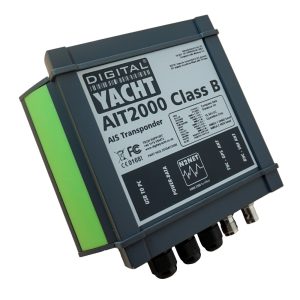

COMMENTS
The AIT2000 is an AIS transponder class B. It uses the latest AIS Transponder technology. Therefore squeezing more performance and interfacing options in to a housing that is half the size of our previous generation transponder. This ultra-compact Class B Transponder has three outputs; NMEA 0183, NMEA 2000 and USB connection, therefore allowing ...
KEY FEATURES. Digital Yacht's new CLA2000 is the ultimate SOLAS and inland waterway globally approved Class A AIS transponder. Water and weather proof to IP67 and a full integrated 5" hi-res colour display. The CLA2000 supports a wide range of functionality including electronic chart navigation with optional C-Map MAX charting and AIS ...
AIT1500/2000/3000 CLASS B AIS ... party systems recognising the standard outputs from the CLASS B TRANSPONDER. Digital Yacht reserves the right to update and change these specifications at any time and without notice. 1.2 Position source All marine Automatic Identification System (AIS) transponders utilise a satellite based location system ...
The AIS transponder must have a built-in WiFi interface (such as Nomad, AIT3000, AIT5000, etc.) or must have a NMEA WiFi server (such as WLN10, WLN30, NavLink2) to be configured with the app. Initial programming of the unit with your boat's MMSI, vessel details, etc. plus monitoring of the LEDs, key performance criteria and switching Silent ...
All Digital Yacht AIS transponders have the LEN value = 1, except our AIT1500N2K which has LEN = 6. AIT2500/AIT5000 Disable NMEA 2000 Heading Reception All Class B and Class B+ AIS transponders can transmit the True Heading of the vessel as part of the dynamic data they transmit to other vessels; MMSI Number, Position, COG, SOG, etc.
iAISTX - AIS Transponder with Wi-Fi. $ 749.95. "iAISTX is an AIS transponder with a wireless interface designed specifically for the growing number of boaters who use a tablet for their navigation tasks.". There are a growing number of boaters that use an iPad or Android tablet for their navigation tasks and thus the iAISTX was designed ...
In order to facilitate the use and configuration of our AIS transponders, our new AIS transponders now have a built-in web interface. This is the case for the Nomad 2, iAISTX, iAISTX Plus and AIT5000 (since March 2020). These devices create a WiFi network on board and configure themselves by connecting to WiFi.
A good VSWR ratio should be no more than 2.5. If the radio is higher then it is due to a bad VHF antenna, VHF splitter or VHF cable. To switch the AIS transponder in to "Silent Mode", click the "Silent" button and the blue Silent LED should illuminate. To start transmitting again, simply click the "Silent" button again and the blue ...
The AIT1500N2K is a Class B AIS transponder with NMEA 2000 interface and built in GPS antenna to make installation as easy as possible. The super sensitive design allows below deck mounting on GRP boats such as small yachts, RIBs and center consoles and cuts down on antenna clutter. It connects to your boat's electronics via a plug 'n play ...
Class B+ AIS Transponder (also called Class B SOTDMA) is a new standard that utilises SOTDMA format transmissions which offer a 5W power output (2.5 x more powerful than a regular Class B), a guaranteed time slot for transmission in busy traffic areas and faster update rates depending upon the speed of the vessel.It's ideal for ocean sailors requiring the best possible performance and future ...
The perfect pack to receive AIS and to transmit your position as well as streaming wirelessly all your navigation data on navigation apps & software. In this pack, you have the option to choose between the Class B AIS Transponder AIT2000 or the Class B+ 5W AIS Transponder AIT2500. Both of them have the same functionality but the AIT2500 uses ...
"The AIT2500 is a full function Class B+ SOTDMA AIS transponder with NMEA 0183, NMEA 2000 and USB data outputs. It is supplied with a GPS antenna." ... "Nomad 2 is a portable AIS navigation solution from Digital Yacht. It is a class B AIS transponder with a wireless and USB interface built in for tablets and PCs. It ships with a compact ...
Features: The AIT2000 uses the latest AIS Transponder technology to squeeze more performance and interfacing options into a housing that is half the size of Digital Yacht's previous generation transponder. This ultra-compact Class B Transponder has (3) Outputs; NMEA 0183, NMEA 2000 and USB connection, allowing it to work with every AIS ...
Built-in 50 channel GPS receiver - Output GPS date via NMEA 2000, USB or NMEA0183, ... The third generation AIS transponder form Digital Yacht. The AIT2000 uses the latest AIS transponder technology, increases performance and interfacing options and builds on the success of its predecessor, the very popular Digital Yacht AIT1000, but in a ...
The AIT2000 is an AIS transponder class B. It uses the latest AIS Transponder technology. Therefore squeezing more performance and interfacing options in to a housing that is half the size of our previous generation transponder. This ultra-compact Class B Transponder has three outputs; NMEA 0183, NMEA 2000 and USB connection, therefore allowing ...
The AIT5000 "Nucleus" Class B+ 5W AIS incorporates not only a full function Class B+ AIS transponder but also an antenna splitter allowing the main VHF antenna on the boat to be shared with the AIS and VHF. It's design also incorporates the latest interfacing capability including NMEA 0183, NMEA 2000, USB and a WiFi server to allow ...
The AIT1500N2K is a Class B AIS transponder with NMEA 2000 interface and built in GPS antenna to make installation as easy as possible. The super sensitive design allows below deck mounting on GRP boats such as small yachts, RIBs and center consoles and cuts down on antenna clutter. It connects to your boat's electronics via a plug 'n play ...
CLASS B AIS TRANSPONDER ... PWR/DATA cable, via the NMEA 2000 interface cable and/or to a PC via the USB interface. ... • The AIT3000 also has an N2Net connection which is Digital Yacht's NMEA2000 compliant interface. To connect to other NMEA2000 products, simply find or add a spare NMEA2000 "T" piece on the existing NMEA2000 ...
The AIT5000 is the latest AIS Transponder with a 5W power output, a Wi-Fi interface, a built-in VHF splitter and utilises SOTDMA format transmissions. ... Digital Yacht have introduced a new range of Class B+ AIS transponders. ... NMEA 2000 and USB interface. Receive AIS targets on software or applications - If you only want to receive AIS ...
If the AIS transponder doesn't have a built-in VHF splitter (i.e. AIT5000), there are 2 options: either install a dedicated VHF antenna for AIS or install an antenna splitter so that the main VHF antenna is used for both VHF radio and AIS. ... A Digital Yacht NMEA 2000 Starter Kit is a cost effective way to build a small, expandable network ...
The AIT2000 is an AIS transponder class B. It uses the latest AIS Transponder technology. Therefore squeezing more performance and interfacing options in to a housing that is half the size of our previous generation transponder. This ultra-compact Class B Transponder has three outputs; NMEA 0183, NMEA 2000 and USB connection, therefore allowing ...
"The AIT2500 is a full function Class B+ SOTDMA AIS transponder with NMEA 0183, NMEA 2000 and USB data outputs. It is supplied with a GPS antenna." ... DIRECT SHIPPING FROM DIGITAL YACHT. EXCELLENT CUSTOMER SERVICE. SECURE PAYMENT. PRODUCTS . AIS systems ; Internet on board ; Sensors ; NMEA interface ; PC on board ; Portable navigation ;